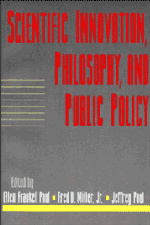Book contents
- Frontmatter
- Contents
- Introduction
- Acknowledgments
- Contributors
- The Human Genome Project: Research Tactics and Economic Strategies
- Choosing Who Will Be Disabled: Genetic Intervention and the Morality of Inclusion
- Germ-Line Genetic Engineering and Moral Diversity: Moral Controversies in a Post-Christian World
- Self-Critical Federal Science? The Ethics Experiment within the U.S. Human Genome Project
- When Politics Drives Science: Lysenko, Gore, and U.S. Biotechnology Policy
- Biotechnology and the Utilitarian Argument for Patents
- Property Rights Theory and the Commons: The Case of Scientific Research
- Property Rights and Technological Innovation
- Medicine, Animal Experimentation, and the Moral Problem of Unfortunate Humans
- A World of Strong Privacy: Promises and Perils of Encryption
- Computer Reliability and Public Policy: Limits of Knowledge of Computer-Based Systems
- Responsibility and Decision Making in the Era of Neural Networks
- Preposterism and Its Consequences
- Index
Self-Critical Federal Science? The Ethics Experiment within the U.S. Human Genome Project
Published online by Cambridge University Press: 04 August 2010
- Frontmatter
- Contents
- Introduction
- Acknowledgments
- Contributors
- The Human Genome Project: Research Tactics and Economic Strategies
- Choosing Who Will Be Disabled: Genetic Intervention and the Morality of Inclusion
- Germ-Line Genetic Engineering and Moral Diversity: Moral Controversies in a Post-Christian World
- Self-Critical Federal Science? The Ethics Experiment within the U.S. Human Genome Project
- When Politics Drives Science: Lysenko, Gore, and U.S. Biotechnology Policy
- Biotechnology and the Utilitarian Argument for Patents
- Property Rights Theory and the Commons: The Case of Scientific Research
- Property Rights and Technological Innovation
- Medicine, Animal Experimentation, and the Moral Problem of Unfortunate Humans
- A World of Strong Privacy: Promises and Perils of Encryption
- Computer Reliability and Public Policy: Limits of Knowledge of Computer-Based Systems
- Responsibility and Decision Making in the Era of Neural Networks
- Preposterism and Its Consequences
- Index
Summary
INTRODUCTION
On October 1, 1988, thirty-five years after co-discovering the structure of the DNA molecule, Dr. James Watson launched an unprecedented experiment in American science policy. In response to a reporter's question at a press conference, he unilaterally set aside 3 to 5 percent of the budget of the newly launched Human Genome Project to support studies of the ethical, legal, and social implications of new advances in human genetics. The Human Genome Project (HGP), by providing geneticists with the molecular maps of the human chromosomes that they use to identify specific human genes, will speed the proliferation of a class of DNA-based diagnostic and risk-assessment tests that already create professional ethical and health-policy challenges for clinicians. “The problems are with us now, independent of the genome program, but they will be associated with it,” Watson said. “We should devote real money to discussing these issues.” By 1994, the “ELSI program” (short for “Ethical, Legal, and Social Implications”) had spent almost $20 million in pursuit of its mission, and gained both praise and criticism for its accomplishments.
In this essay, I offer an evaluation of the ELSI experiment as one example of how society and the scientific community might go about addressing the policy issues raised by scientific innovation. My assessment is drawn from my experience as one of this experiment's principle labtechs and bottle-washers during my tenure as Chief of the ELSI Branch at the National Institutes of Health (NIH)'s National Center for Human Genome Research (NCHGR) between 1990 and 1994.
- Type
- Chapter
- Information
- Scientific Innovation, Philosophy, and Public Policy , pp. 63 - 95Publisher: Cambridge University PressPrint publication year: 1996
- 2
- Cited by



